La Muerte Negra ("Black Death"). Episodes of the Falkland War
21 aerial victory without a single defeat!
The achievements of Sea Harrier fighters in the Falkland War are genuinely surprising and admiring. British pilots performed their exploits over the ocean, in 12, thousands of kilometers from their native shores. Taking off from the slippery swinging decks of aircraft carriers, in terms of the numerical superiority of the enemy in the air. Subsonic VTOL of anti-supersonic Argentine Mirage!
21 Account: 0
28 "Harrier Sea" of the 800th, 801st and 809th Royal Navy squadrons crushed the Argentinean Aviation, ensuring the British victory in the conflict!
Or have we missed something?
Crushed squadron
Sunk:
- Sheffield destroyer;
- the destroyer "Coventry";
- frigate "Ardent";
- frigate "Entiloup";
- amphibious assault ship "Sir Galahed";
- transport / helicopter carrier "Atlantic Conveyor";
- landing boat Foxtrot Four (from the composition of the UDC HMS Fearless).
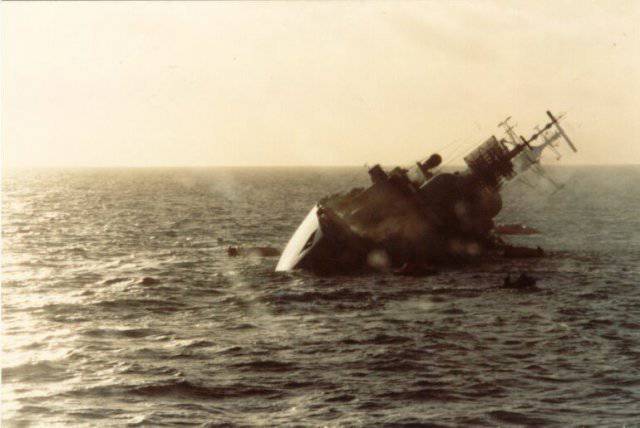
Damaged:
- the destroyer "Glasgow" - 454-kg unexploded bomb stuck in the engine room;
- the destroyer "Entrim" - unexploded bomb;
- the destroyer "Glamorgan" - PKR "Exochet" (the only one on the list, damaged by fire from the shore);
- the frigate Plymouth - four (!) Unexploded bombs;
- the frigate "Argonaut" - two unexploded bombs, the "Argonaut" was in the balance from death;
- the frigate "Elekriti" - unexploded bombs;
- Arrow frigate - damaged by aircraft cannon fire;
- frigate "Broadsward" - punched through the unexploded bomb;
- frigate "Brilliant" - shot by "Daggers" from a strafing flight;
- landing ship "Sir Lancelot" - 454 kg unexploded bomb;
- the landing ship "Sir Tristram" - damaged by bombs, completely burned out, evacuated on a semi-submerged platform;
- amphibious assault ship "Sir Bedivere" - unexploded aerial bomb;
— naval British Way tanker - an unexploded bomb;
- transport "Stromness" - unexploded air bomb.
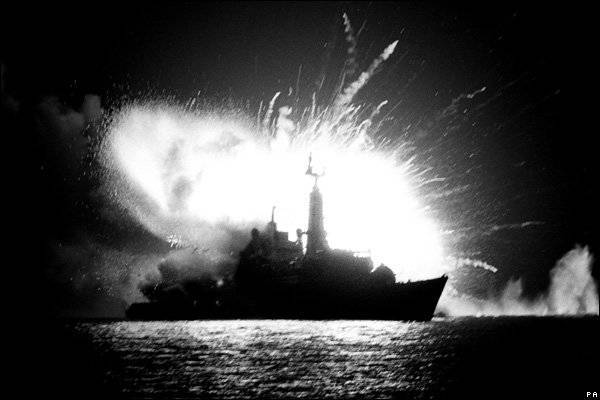
It is obvious that "Sea Harriers" failed the task of covering the ships by air. Argentinean pilots managed to bomb a third of the squadron. If all the bombs had exploded, the Falkland Islands would now be called Malvinas.
8 was knocked out of 5 destroyers. From 15 frigates - 8. From 8 landing ships and UDC was sunk and damaged 4. Many ships were hit repeatedly.
Before being bombed, the Argonaut was attacked by the Argentine military-training Ayrmakki, which holed the entire superstructure through the frigate.
"Sir Galadad" could have died on the way to the islands: an 454-kg bomb dropped by A-4 "Skyhawk" attack aircraft got stuck in its hull. If the bomb had worked normally on a ship full of paratroopers, the British could lose the battalion of marines at once. Fortunately, fate was favorable: "Sir Galadhad" was sunk later, near the coast. Killed 48 people.
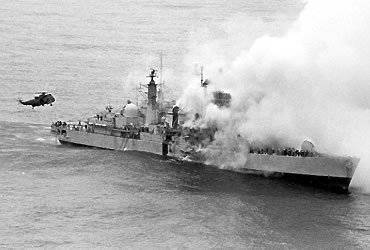
The pilots of the Argentine Air Force and Navy attacked ships with free-fall bombs, launched anti-ship missiles, shot the poor pelvis from a strafing flight. It was as if they had never heard of La Muerte Negra - the Sea Harrier fighters who won the aerial victory of 21 without a single defeat!
How are the victorious reports of the British aces combined with twenty bombed ships?
Argentines called the Sea Harriers "black death" - and at the same time, as if not noticing the danger, attacked enemy ships from all sides. British sailors are very lucky that 80% of the Argentine bombs hit the target did not explode.
Curiously, the bombs were Mk.80 - made in the USA.
Harrier Success Secrets
The list of air victories of the British VTOL are as follows:
- 9 fighter-bombers "Dagger";
- X-NUMX A-8 Skyhawk attack aircraft;
- 1 fighter "Mirage III";
- 1 bomber "Canberra";
- 1 piston attack aircraft "Pukara";
- 1 military transport C-130 "Hercules".
Also in the trophy of "Sea Harriers" you can record one victory by combat maneuvering over a helicopter, as well as 1 "Pukar" and 2 of Argentine helicopters destroyed on the ground.
The British themselves also suffered losses: two "Sea Hariera" were shot down by air defense fire, three crashed for non-combat reasons, another slipped overboard in stormy weather.
Also in the conflict were ground-based 10 "Harriers" from the Royal Air Force. Due to the absence of the radar, they did not participate in air battles and were used exclusively as a means of fire support. Four aircraft were lost from 10: 3 was shot down by anti-aircraft fire, 1 crashed for a non-combat reason.
Debriefing
The myth of the "supersonic Mirages" is somewhat exaggerated - among the trophies of "Sea Harriers" is only one Mirage III fighter. About the rest should tell more.
Fighter-bomber "Dagger" - former. IAI Nesher, an Israeli unlicensed copy of the Mirage-5. Cheap "shock" aircraft for action in the daytime, in the clear sky of Palestine. By the end of the 1970-x "Nesher" were decommissioned and sold to Argentina under the designation Dagger.
The main drawback of the Daggers was the lack of radar. Under the conditions of the South Atlantic (stormy weather, poor visibility, “violent 50-e”) it was very problematic to conduct an air battle without radar. As a result, the Daggers became easy prey for enemy fighters.
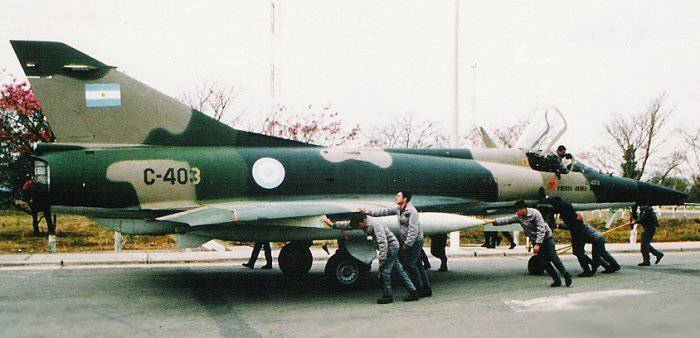
Worse, they did not have an in-flight refueling system and were forced to carry the maximum amount of fuel with them. There could be no talk of any “supersonic” - overloaded with bombs and PTB, the “Daggers” cruised out to the coast about. Zap. Falkland to test their inertial navigation systems. La Muerte Negra was waiting for them there - combat air patrols of the British "Sea Harriers".
While the British aces filled their accounts, chasing the helpless Daggers, other Argentinean airplanes, specialized A-4 Skyhawk ground attack aircraft, made the 500-kilometer hook and went to the flank of the main forces of the British squadron. And the battle began.
“Skyhawk” is a light subsonic aircraft carrier-based vehicle equipped with an in-flight refueling system, thanks to which A-4 could operate on any remote theater of operations without any problems. Unlike the American bombs, the Skyhawk proved to be a reliable and unpretentious car - it was these planes that caused the main damage to the British squadron. It was noted simplicity and high survivability attack aircraft. The landing hook was very useful when flying from the icy runway of the Rio Grande airbase.
A known case of landing a damaged A-4. The plane independently touched the lane and, having swept over a given distance, stopped. Alas, his pilot was less fortunate: just before the landing, the pilot lost his nerves, he jerked the catapult lever and, when hitting the concrete tank, received injuries incompatible with life.
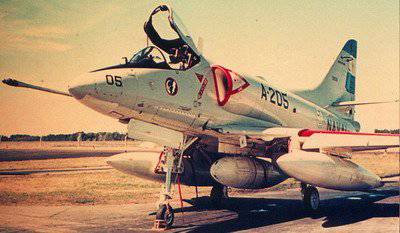
“Skyhawks” boldly flew forward into the open ocean - punching low clouds with a wing, through rain and snow charges. The tanker was waiting for them at the settlement point - the only active KS-130 of the Argentine Air Force. After refueling, the group set off to search for the enemy, to be removed over 1000 km from the coast. The main problem was to detect the British ships without the aid of radar and modern NCP. Surprisingly, in such extreme conditions the Argentine pilots managed to achieve great success.
On the way back it was necessary to find the tanker again, otherwise the plane would fall into the ocean with empty tanks. No insurance was allowed to pilots - the crashed turned out to be alone with the bitter spirit of the elements, without a chance for salvation. British Sea Harriers bombarded any tugboat sent in search of missing pilots.
Argentina has given the world not only first-class football players and 1 Formula drivers, but also courageous combat aviation pilots. The pilots of the Argentine Air Force flew at close range to ships equipped with modern air defense systems. Neither the anti-aircraft guns nor the vaunted "Sea Harriers" could stop them.
Despite losing the war, the pilots became national heroes. They did everything possible and impossible to win, but luck was not on their side. 80% bombs did not explode.
Skyhawks suffered heavy losses: the 22 aircraft did not return to Rio Grande. 10 were the victims of the air defense of ships. 8 shot down "Sea Harriers". 1 was hit by "friendly fire". Three more disappeared in the expanses of the ocean.
A detailed account of the English Electric Canberra and the Pukara attack aircraft can be omitted: the old bomber and the turboprop attack aircraft based in the Falkland Islands could not pose a threat to Sea Harrier. When they met, they became easy prey for the British.
The case of the interception of the “Hercules” is indicative (a four-engine military transport aircraft, analogue to the An-12). The Sea Harrier fired two missiles at him, but the Hercules, whistling with the three remaining engines, continued to pull toward the Argentine coast. Then the "Sea Harrier" approached, and thrust 240 projectiles at point blank range - the entire ammunition for onboard guns. The flaming debris of the "Hercules" fell into the waves.
The only worthy victory for British pilots is the Argentine Mirage III, shot down on 1 in May 1982. By the way, here, too, the Sea Harrier had 2 objective advantages.
Like all Mirages, the downed Argentine fighter did not have a refueling system and was overloaded with fuel. The presence of the PTB imposed restrictions on maneuvering and flying at high supersonic speeds.
Secondly, in view of the better financial position of the British armed forces, the Sea Harriers were equipped with rockets with an all-view homing head, the Sidewinder AIM-9L modification. Alas, the Argentines had nothing of the kind. All this gave Sea Harrier pilots a significant advantage in aerial combat.
Apart from the case described above, the Sea Harriers no longer managed to meet with the Mirage III fighters - all of them were withdrawn to protect the sky over Buenos Aires.
Results and conclusions
Everything connected with the Falkland War is permeated with a certain amount of irony. The conflict between the two not-so-secured powers on the edge of the Earth - improvisation, impromptu, unexpected tactical decisions. Argentina's flying junk against the rusty pelvis of Her Majesty.
All this is really funny.
The fact that tracking the sea situation was entrusted to the P-2 “Neptune” aircraft of the 1945 design of the year speaks well about the state of Argentine aviation. When he collapsed from decrepitude, the passenger Boeing-707 began to drive over the ocean.
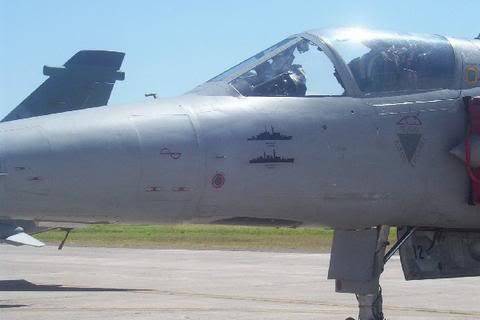
The intensity of the sorties of Argentine aviation due to the remoteness of the theater and the presence of a single flying tanker was small. But the main problem of the Argentine Air Force were bombs. What is the reason for such low reliability? On this account the opinion of the sources diverges. According to some data, the low height of the discharge affected - the fuses simply did not have time to get on the combat platoon. According to another version, it’s all about 30-year storage in the warehouse without proper maintenance. The third conspiracy theorizes that American export weapon will not explode a priori (which, however, is refuted by the success of Skyhawk attack aircraft).
But one thing is for sure - the bombs did not explode.
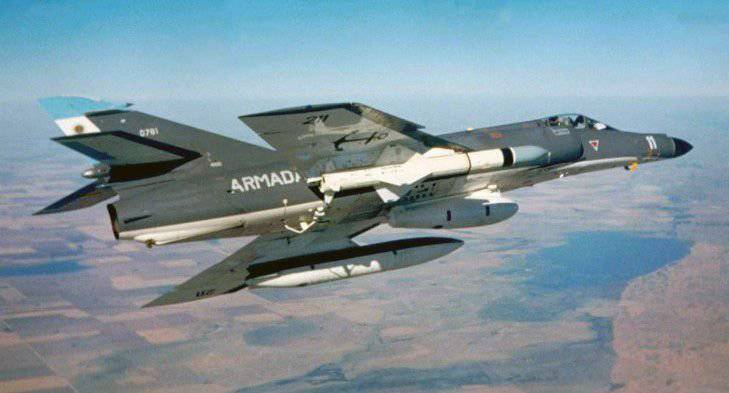
It is noteworthy that the military core of the Argentine aviation - really modern fighter-bombers of the French production "Super Etandar" (with supersonic flight speed, radar, refueling system and air-based anti-ship missiles) - had no losses. They rushed over the ocean with an arrow, calculated the location of enemy forces with a radar - and launched rockets without entering the British air defense zone. The “Sea Harrier” pilots only shrugged their shoulders: “Super Etandar” is not a blind-minded Dagger or awkward Skyhawk attack aircraft.
The Argentines had only five operating "Super Etandars" and to them a set of six anti-ship missiles "Exochet". That was enough to destroy the Sheffield destroyer and the Atlantic Conveyor helicopter carrier without any loss. It is terrible to imagine what the outcome of the war would be if all of the 14 ordered Super Supertars and a full complement of 24 anti-ship missiles had arrived in Argentina.
Based on these facts, the British "vertical-riders" had to operate in extremely favorable conditions against the outdated aircraft of the Argentine Air Force. However, even the “handicap” in the form of the presence of radar and missiles AIM-9L did not help protect the squadron from the raids of subsonic Skyhocks. Nearly three dozen VTOL aircraft were uselessly flying over the ocean, unable to intercept rare groups of Argentine planes.
It got to the point that the aircraft carriers Hermes and Invincible could not approach the islands at all. The British had no illusions about the destructive qualities of "Sea Harriers". And they well understood what aircraft carriers would expect if at least one small bomb would fall on their deck. Therefore, the area of combat maneuvering of aircraft carriers was located in 150 miles northeast of Falklands, outside the range of the Argentine aviation. That is why they are not in the lists of losses.
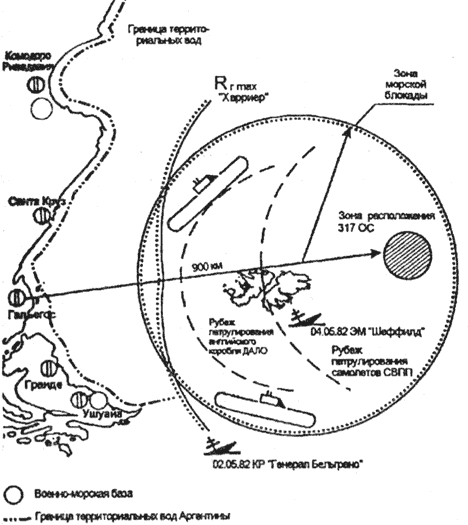
All of this made the work of Sea Harriers even more difficult. Providing effective air cover from such a distance turned out to be impossible. The fighters did not have enough fuel. At this time, the Argentine aviation continued to smash the main forces of the squadron, trying to land on the islands.
During the years of the Great Patriotic War, our grandfathers and great-grandfathers remained without awards, if during the sortie a group of escorted bombers suffered losses from the actions of enemy fighter aircraft. And no matter how many Messers were shot down, the main task was failed, the bombers did not bring their bombs to the target. A very telling example.
The Falkland triumph of "Sea Harrier" was in fact a disaster. The British squadron almost died under air strikes. The cost of one sunk destroyer exceeded the cost of all enemy aircraft shot down by Sea Harriers. What kind of success can we talk about?
The war on the outskirts of the Earth clearly showed that even such an “advanced” VTOLP as the “Sea Harrier” turned out to be completely ineffective when meeting with classical jet aircraft of the same period.
According to materials http://artofwar.ru
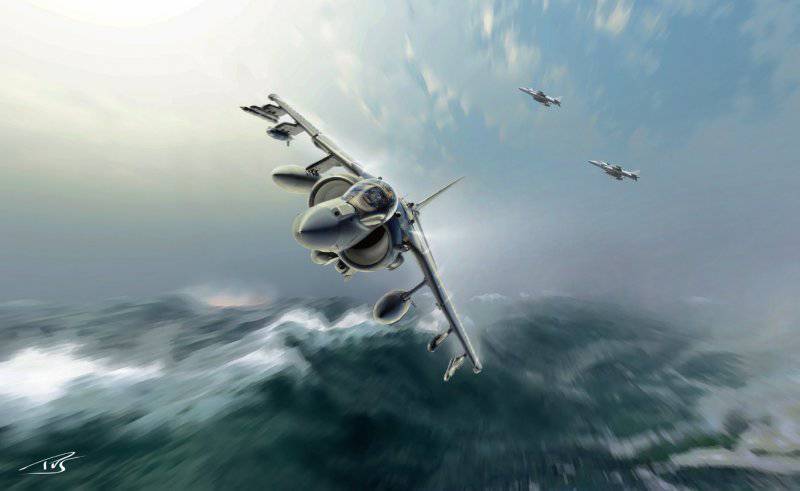
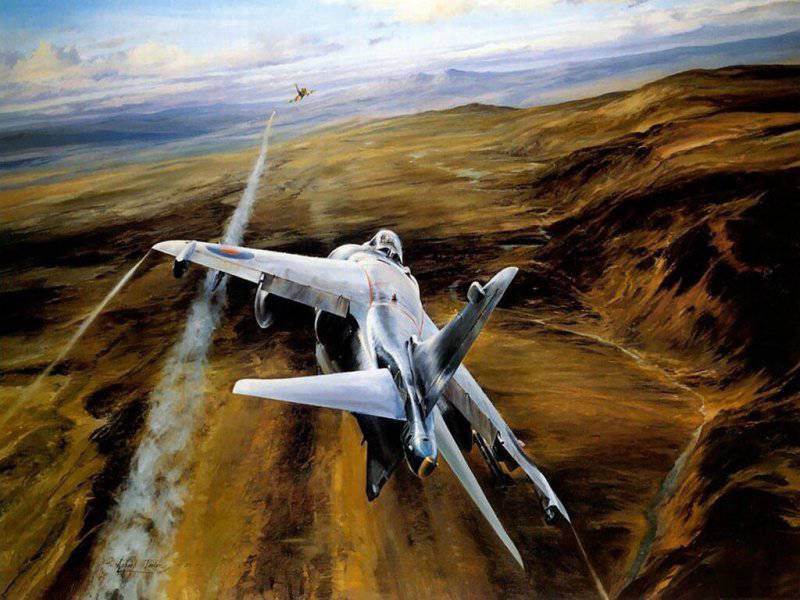
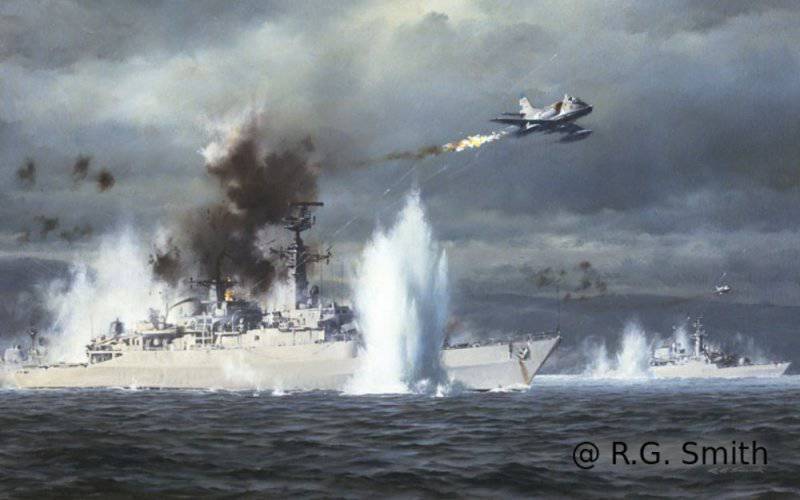
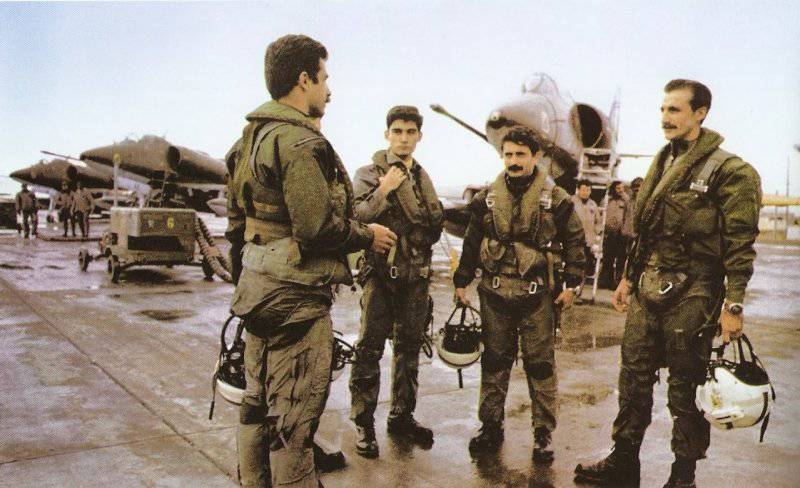
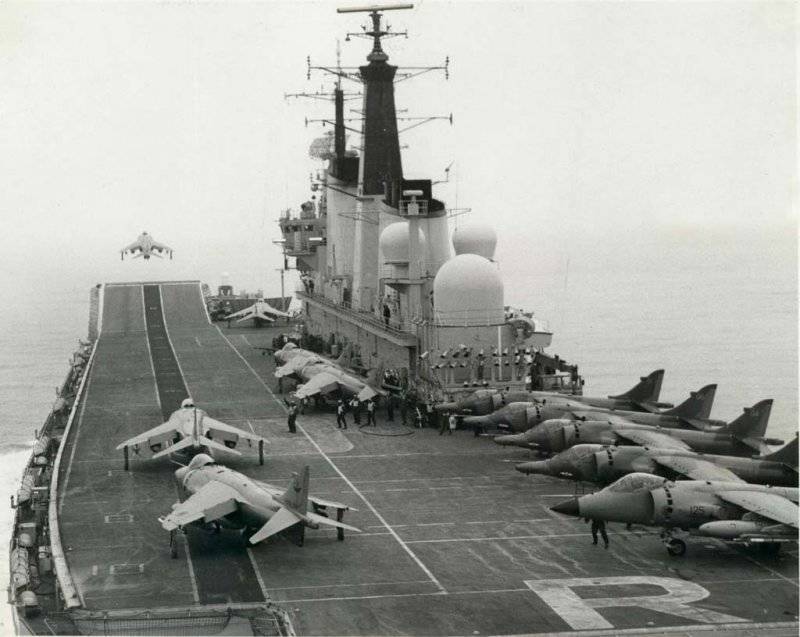
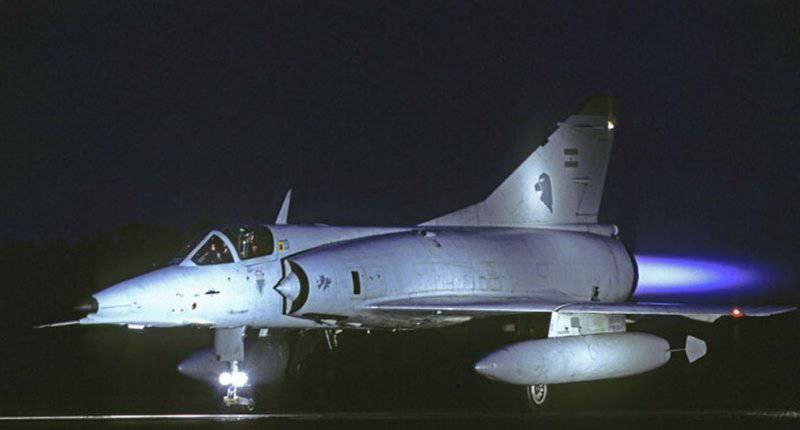
Information